Applied Research
The analytical methodology and testing procedures developed in the project are used in the work of the GCI's Museum Research Laboratory and in numerous collaborative projects with the J. Paul Getty Museum and GRI, and in selected collaborations with museums, archives, and photographic collections, to provide scientific information for conservation treatments of photographs. They are also used to advance knowledge of artist techniques and practices, and to support provenance and authentication studies related to photographs and photographic material.
Recent applied research projects include:
- scientific investigation and preventive treatment of the world's first photograph
- scientific investigation of the baryta-layer coating used in black-and-white photographic paper
- scientific investigation of three Niépce plates in the collection of the Royal Photographic Society at the National Media Museum, Bradford, UK
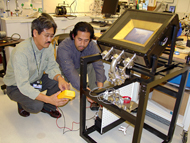
|
|
The First Photograph Project
In June 2002, the world's first photograph, Joseph Nicéphore Niépce's View from the Window at Le Gras (1826), arrived at the GCI for scientific analysis. Niépce's work, part of the photographic collection of the Harry Ransom Humanities Research Center at the University of Texas at Austin, is the first example of a permanent image created by exposing a photosensitive plate in a camera-like device. Although Niépce's process was generally documented, the image itself had never before been scientifically analyzed. The Ransom Center asked the Institute to conduct the first scientific study of the heliograph's material makeup and to determine the object's state of conservation.
The GCI scientific team used noninvasive analytical techniques, including X-ray fluorescence (XRF), Fourier-transform infrared spectrometry (FTIR), and reflection spectrophotometry to study the image. The XRF analysis confirmed the plate to be pewter composed of lead, copper, nickel, and iron. FTIR and microscopic analysis confirmed the image layer to be bitumen—though not a solid layer as presumed but, rather, a layer of microdots. This unexpected discovery raises new questions about the image's creation and its preservation. The overall state of conservation of the photograph was good; only small areas of corrosion were noted around its edges.
Work Completed
Working in collaboration with the project team and the Harry Ransom Center at the University of Texas at Austin, scientists from the GCI designed, tested, and installed a new protective enclosure for the first photograph.
The high-tech protective enclosure not only helps to preserve the photograph in a nitrogen atmosphere, free of oxygen, but it also makes use of a highly sophisticated set of sensors to guard the work against any changes to its protective atmosphere.
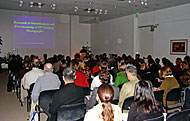
|
|
Baryta Layer Research Symposium
This one-day symposium took place at the GCI in January 2006 and was attended by seventy-five participants including conservators, conservation scientists, dealers, appraisers, and curators. The focus of the event was a discussion of results from the ongoing collaboration between the project team and Boston-based independent conservator Paul Messier to characterize certain features of twentieth-century photographic paper.
Giacomo Chiari, then-chief scientist at the GCI, provided symposium participants with an introduction to the GCI's research agenda and reiterated the Institute's commitment to additional research into the characterization of photographic materials.
Discussion of baryta layer reasearch began with Paul Messier who discussed the development of his reference collection of historic photographic papers. Papers from this collection, all identified by manufacturer, brand, date, and finish were the basis for much of the work highlighted during the rest of the symposium.

|
|
Senior Scientist Dusan Stulik (now retired) presented the results of an extensive examination of the historic paper samples using X-ray fluorescence spectroscopy (XRF). Among the common elements detected were barium and strontium (from the baryta layer), calcium (paper base), and often chromium (present as a gelatin-hardening agent). Measurement of these elements, especially when compared to the baseline of papers of known provenance, can provide clues into the origins of prints, possibly identifying the manufacturer, brand, and date.
David Miller, professor of Chemistry at California State University, Northbridge, reviewed his work using inductively coupled plasma-mass spectrometry (ICP–MS) and neutron activation analysis (NAA) for elemental analysis of photographic papers. These techniques were used to confirm and extend the quantitative XRF analysis as well as to search for additional trace elements that could be useful in provenance studies.
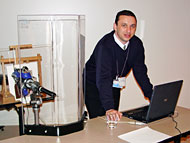
|
|
GCI project team member Art Kaplan discussed the distribution of key elements, as well as trace elements such as aluminum, silicon, potassium, manganese, iron, copper, potassium and chromium within the multiple layers of a gelatin silver photograph. Cross sections of photographic paper were used to render elemental maps showing the location and relative concentrations of these and other elements. The cross sections were analyzed using an environmental scanning electron microscope (ESEM) as well as a combination of energy dispersive X-ray analyzer (EDX) and ICP–MS.
Renaud Duverne presented the project's research into the measurement of other physical parameters of gelatin silver paper, including baryta particle size, overall paper thickness, emulsion thickness, emulsion super coat thickness, baryta thickness, and overall paper density. All of these variables, especially when combined with techniques for elemental analysis, can be extremely useful for characterizing a large reference collection of photographic papers.
Dusan Stulik and GCI Project Specialist Tram Vo provided a practical demonstration of how the quantitative XRF technique can be used to identify the manufacturer and brand of photographic paper used in a photograph of unknown origin by comparing the paper to a small reference set of characterized papers.
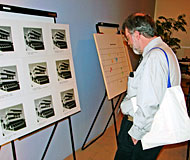
|
|
The symposium concluded with a roundtable discussion. Dominant themes of the discussion included the need for additional forums for conservators, curators and dealers to exchange information; the need for additional collaborative projects to characterize other photographic features, such as paper fiber analysis and surface texture; and the fact that these emergent tools will only serve to compliment, but not replace, existing modes of connoisseurship.
The symposium abstracts are available in PDF format:
Baryta Layer Symposium Abstracts (30pp., PDF format, 2.3MB)
Niépce in England Conference
A two day-long conference, coorganized by the GCI, took place at the National Media Museum (NMeM) in Bradford, United Kingdom, on October 13 and 14, 2010. It was attended by more than one hundred thirty art historians of photography, conservation scientists, conservators, curators of photographic collections, scientists, photographers, and students of art history and photography, as well as the interested public.
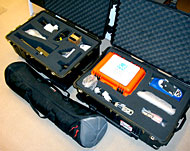
|
|
The conference focused on the results of a NMeM-GCI collaborative research project which conducted the first scientific investigation and analysis of three photographic plates created in the 1820s by a French pioneer of photography, Joseph Nicéphor Niépce. These photographic images are some of the most important artifacts of the early history of photography. The three photographic plates came to England together with the so-called First Photograph produced by Niépce (currently at the Harry Ransom Center of the University of Texas in Austin), along with several other photographic plates that vanished during the first half of the nineteenth century. Changing owners several times, the three plates ended up as an important part of the Royal Photographic Society Collection of Photographs (RPS), which is currently housed within the NMeM collection of photographs.
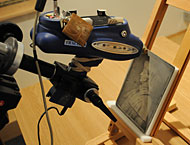
|
|
The results of the NMeM-GCI scientific investigation of all three plates provided insight into the chemistry of the image layer of the plates and the chemical composition of the pewter substrates. Previously described as acid-etched images into pewter or tin plates, the scientific investigation of the NMeM plates showed that each plate was created using a different image making process and that the Un Claire de Lune plate has never been etched at all; its image layer, unlike the First Photograph plate in Austin, does not contain bitumen but is chemically very close to the oil of lavender resin produced by oven heating. Investigation of the Cardinal d'Amboise plate demonstrated that while it was deeply etched for printing using printing ink, it has never been inked or printed from. On the other hand, study of the Christ Carrying His Cross plate showed only a very shallow acid etch that could not be printed from. This plate still contains a very thin veil of bitumen; it represents a unique, photo-chemically produced image that can be framed for display or exhibition.
In addition to the findings of the scientific investigation, the Niépce in England conference also provided an opportunity for historians to present results of the latest research into: 1) the provenance of all three plates; 2) Niépce's whereabouts when in England; 3) Niépce's dealings with the Royal Society and several of its important members; and 4) Niépce's attempts to present his invention to the Royal Court.

|
|
Also reported at the conference were the results of the forensic investigation of several fingerprints discovered on several plates by the NMeM-GCI project team, as well as the results of investigation of paper labels and paper artifacts attached to some of the plates. Additionally presented were the provenancing and stylistic analysis of all existing frames of the plates conducted by experts from the National Gallery in London. Conservators offered detailed descriptions of the conservation state of all four existing plates that were brought to England by Niépce in 1827 and provided information on the current preventive conservation measures developed by the GCI-Harry Ransom Center project team for the First Photograph—as well as a projected plan for the future storage and display of the three Niépce's plates from the NMeM's RPS collection of photographs.
The papers presented at the Niépce in England conference are available from the website of the Royal Photogaphic Society. The conference abstracts are currently available at the NMeM Web site.
Page updated: October 2015

